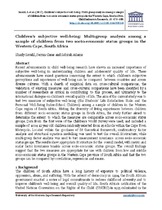| dc.contributor.author | Savahl, Shazly | |
| dc.contributor.author | Casas, Ferran | |
| dc.contributor.author | Adams, Sabirah | |
| dc.date.accessioned | 2018-09-04T10:06:50Z | |
| dc.date.available | 2018-09-04T10:06:50Z | |
| dc.date.issued | 2017 | |
| dc.identifier.citation | Savahl, S. et al. (2017). Children’s subjective well-being: Multi-group analysis among a sample of children from two socio-economic status groups in the Western Cape, South Africa. Child Indicators Research, 10: 473–488. | en_US |
| dc.identifier.uri | http://dx.doi.org/10.1007/s12187-016-9392-0 | |
| dc.identifier.uri | http://hdl.handle.net/10566/4002 | |
| dc.description.abstract | Recent advancements in child well-being research have shown an increased importance of subjective well-being in understanding children and adolescents’ quality of life. These advancements have raised questions concerning the extent to which children’s subjective perceptions and experiences of well-being can be compared between countries and across diverse cultures. With a dearth of empirical data on cross-cultural comparisons, the validation of existing measures and cross-cultural comparisons have been identified by a number of researchers as critical in contributing to this process, and ultimately to the international dialogue on children’s overall quality of life. The aim of the current study was to test two measures of subjective well-being (the Students’ Life Satisfaction Scale and the Personal Well-Being Index-School Children) among a sample of children in the Western Cape region of South Africa. Noting the diversity of living experiences between children from different socio-economic status groups in South Africa, the study further aimed to determine the extent to which the measures are comparable across socio-economic status groups. Data from the first wave of the Children’s World Survey were used; and included a sample of 1004 12 year old children randomly selected from 15 schools within the Cape Town Metropole. Located within the goodness of fit theoretical framework, confirmatory factor analysis and structural equation modelling was used to test the overall fit structure; while multi-group factor analysis was used to test measurement invariance across socio-economic status groups. The results show appropriate fit structure for the overall model, with metric and scalar factor invariance tenable across socio-economic status groups. The overall findings suggest that the two measures are appropriate for use with children from low and middle socio-economic status groups in the Western Cape province of South Africa and that the two groups can be compared by correlations, regressions and means. | en_US |
| dc.language.iso | en | en_US |
| dc.publisher | Springer Verlag | en_US |
| dc.rights | This is the author-version of the article published online at: http://dx.doi.org/10.1007/s12187-016-9392-0 | |
| dc.subject | Children | en_US |
| dc.subject | Subjective well-being | en_US |
| dc.subject | Socio-economic status | en_US |
| dc.subject | Confirmatory factor analysis | en_US |
| dc.subject | Structural equation modelling | en_US |
| dc.title | Children’s subjective well-being: Multi-group analysis among a sample of children from two socio-economic status groups in the Western Cape, South Africa | en_US |
| dc.type | Article | en_US |
| dc.privacy.showsubmitter | FALSE | |
| dc.status.ispeerreviewed | TRUE | |
| dc.description.accreditation | ISI | |

